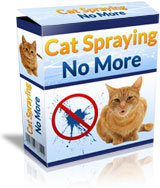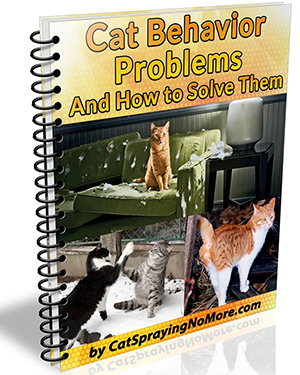Uncategorized
Keep Your Cat Full Longer with These Foods: A Guide to Satisfied Felines
Is your cat a constant food beggar, even after a meal? Do they seem perpetually hungry, leading to overeating or unwanted weight gain? You’re not alone. Many cat owners face the challenge of a seemingly insatiable feline appetite. The good news is that by making smart choices about the types of food you offer, you can help keep your cat feeling fuller for longer, promoting better health, a healthy weight, and a more content companion.
The key to feline satiety lies in understanding a cat’s natural dietary needs and how different macronutrients affect their hunger cues. Cats are obligate carnivores, meaning their bodies are designed to thrive on a diet primarily composed of animal protein and fat, with very limited carbohydrates.
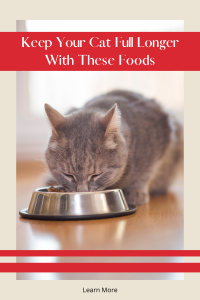
Here are the food characteristics and specific ingredients that can help keep your cat satisfied and less prone to persistent hunger:
1. Prioritize High-Quality Animal Protein
Protein is the cornerstone of a cat’s diet and plays a crucial role in satiety. Protein takes longer to digest than carbohydrates, helping your cat feel full and satisfied for extended periods. Look for cat foods where a named animal protein (like chicken, turkey, salmon, or beef) is the very first ingredient.
- Why it works: High-quality animal protein provides the essential amino acids cats need while signaling to their brain that they’ve consumed adequate nutrients.
- What to look for: Foods with 30-50% protein content on a dry matter basis. Avoid foods with excessive plant-based proteins as primary sources, as these are less bioavailable for cats.
2. Embrace Moisture-Rich Wet Food
One of the simplest and most effective ways to increase satiety and overall health in cats is to incorporate more wet food into their diet. Wet food, by its nature, has a high water content (typically 70-80%), which adds volume to the stomach without adding excessive calories.
- Why it works: The high moisture content helps fill your cat’s stomach, creating a feeling of fullness. It also contributes significantly to hydration, which is vital for kidney and urinary tract health, particularly in indoor cats.
- What to look for: Canned or pouched wet foods with high-quality animal protein as the main ingredient. Gravies and broths can further enhance the filling effect.
3. Choose Moderate, Healthy Fats
While often feared for their calorie density, healthy fats are an essential part of a cat’s diet and contribute to satiety. Fats are calorie-dense, providing concentrated energy, and they slow down digestion, helping to prolong the feeling of fullness.
- Why it works: Fats provide a sustained energy release and promote a feeling of satisfaction.
- What to look for: Foods with moderate fat levels (around 15-25% on a dry matter basis) from animal sources like poultry fat or fish oil. Omega-3 fatty acids (DHA, EPA) found in fish oil also offer anti-inflammatory benefits.
4. Opt for Low Carbohydrate Formulas
Cats have a limited physiological need for carbohydrates. Diets high in simple carbohydrates can lead to rapid spikes and drops in blood sugar, potentially contributing to feelings of hunger shortly after eating. Excess carbs are also readily stored as fat, increasing the risk of obesity.
- Why it works: Limiting carbohydrates helps prevent blood sugar rollercoasters, leading to more stable energy levels and a more consistent feeling of fullness.
- What to look for: Cat foods with carbohydrates typically under 10-15% on a dry matter basis. Avoid foods with large amounts of corn, wheat, soy, or other starchy fillers.
5. Consider Added Fiber (in Moderation)
While cats don’t need a lot of fiber, a moderate amount can aid digestion, help regulate blood sugar, and contribute to a feeling of fullness. Certain types of fiber can also help manage hairballs.
- Why it works: Fiber adds bulk to the stool and can help slow down digestion.
- What to look for: Small amounts of ingredients like psyllium husk, beet pulp, or pumpkin in the ingredient list. Overdoing fiber can dilute nutrient absorption, so moderation is key.
Beyond the Bowl: Feeding Strategies
Even with the right food, how you feed your cat can impact their satiety. Consider using puzzle feeders or slow-feeder bowls to make mealtime more engaging and prolong the eating experience. Dividing daily portions into two or three smaller meals can also help manage hunger throughout the day.
By focusing on high-quality, animal-based proteins, moisture-rich wet foods, healthy fats, and low carbohydrates, you can help your cat feel truly satisfied after their meals, leading to a healthier weight, fewer food-related pleas, and a happier cat overall. Always consult with your veterinarian to tailor dietary advice to your cat’s specific health needs and activity level.
The Best Diet For Indoor Cats: Nourishing Your Feline Friend for a Long, Healthy Life
Introduction
Indoor cats live a different lifestyle than their outdoor counterparts – less activity, different environmental stressors. Their diet needs to reflect these differences to ensure optimal health, prevent common indoor cat ailments, and promote longevity.

I. Understanding the Unique Needs of Indoor Cats
- Reduced Activity Levels:
- Indoor cats typically burn fewer calories.
- Higher risk of obesity, which leads to other health issues (diabetes, joint problems).
- Diet needs to be calorie-controlled.
- Hairball Management:
- Indoor cats groom more, often ingesting more fur.
- Importance of fiber in the diet to help pass hairballs.
- Hydration:
- Often less access to natural water sources (puddles, dew).
- Crucial for urinary tract health (common issue in indoor cats).
- Emphasis on moisture-rich diets.
- Environmental Enrichment (Dietary Aspect):
- Food can be a source of mental stimulation.
- Consider puzzle feeders.
II. Key Nutritional Components of an Ideal Indoor Cat Diet
- High-Quality Animal Protein:
- Cats are obligate carnivores – they must have meat.
- Lean meats (chicken, turkey, fish) as primary ingredients.
- Avoid excessive plant-based proteins as primary sources.
- Importance of essential amino acids like taurine (vital for heart and eye health).
- Moderate Fat Content:
- Energy source, but needs to be balanced due to lower activity.
- Healthy fats (omega-3 and omega-6 fatty acids) for skin, coat, and joint health.
- Sources: fish oil, flaxseed (though cats don’t convert plant omegas as efficiently).
- Low Carbohydrates:
- Cats have limited ability to digest and utilize carbs.
- High carb diets contribute to obesity and diabetes.
- Avoid fillers like corn, wheat, soy.
- Appropriate Fiber:
- Aids digestion, prevents constipation, and helps with hairball passage.
- Sources: psyllium husk, beet pulp, certain vegetables.
- Not too much, as it can reduce nutrient absorption.
- Essential Vitamins and Minerals:
- Ensuring a complete and balanced formula.
- Calcium, phosphorus, Vitamin A, B vitamins, etc.
III. Diet Types: Wet, Dry, or a Combination?
- Wet Food (Canned/Pouches):
- Pros: High moisture content (excellent for hydration and urinary health), often higher in protein and lower in carbs.
- Cons: More expensive, shorter shelf life once opened, can contribute to dental issues if not supplemented with dental care.
- Dry Food (Kibble):
- Pros: Convenient, cost-effective, aids in dental hygiene (some kibbles are specifically designed for this).
- Cons: Low moisture (can contribute to dehydration), often higher in carbohydrates.
- Combination Feeding:
- Often the best of both worlds.
- Offers hydration from wet food and convenience/dental benefits from dry.
- Monitor calorie intake carefully.
- Raw/Homemade Diets:
- Discuss briefly: require extensive research and veterinary guidance to ensure nutritional completeness and safety from pathogens. Not recommended without expert consultation.
IV. Practical Feeding Tips for Indoor Cats
- Portion Control: Follow feeding guidelines based on weight, age, and activity, but adjust as needed. Use a measuring cup.
- Scheduled Meals: Two to three small meals a day rather than free-feeding can help manage weight.
- Fresh Water: Always available, in multiple locations, consider a fountain.
- Treats in Moderation: Choose healthy, low-calorie options.
- Cat Grass: Offer cat-safe plants like oat or wheatgrass for enrichment and fiber (as seen in the image!).
- Regular Vet Check-ups: To monitor weight and overall health.
Conclusion
A thoughtfully chosen diet is fundamental to an indoor cat’s health and happiness. Final thought: By prioritizing high-quality protein, proper hydration, and portion control, you can help your feline friend live a long, vibrant life indoors.
Grooming Kit Essentials for New Cat Parents
Everything You Need to Keep Your Feline Friend Healthy and Happy
Bringing a new cat into your home is an exciting and heartwarming experience. Whether you’ve adopted a playful kitten or a calm adult cat, becoming a pet parent means taking on the responsibility of your furry companion’s well-being. One of the most important — and often overlooked — aspects of cat care is grooming.
Contrary to popular belief, cats can’t handle all grooming tasks on their own. While they do spend a significant amount of time licking and cleaning their fur, they still need your help to stay clean, healthy, and comfortable. Regular grooming reduces shedding, prevents mats, minimizes hairballs, and helps you spot health problems early.
To help you start off on the right paw, here’s a comprehensive guide to grooming kit essentials every new cat parent should have.
1. Brush or Comb (or Both)
Why It’s Essential:
Brushing is the foundation of any grooming routine. It helps remove loose fur, dirt, and dander, while also preventing matting — especially in long-haired breeds.
What to Look For:
- Slicker brushes are great for long-haired cats and help detangle knots.
- Bristle brushes are ideal for short-haired cats to smooth the coat and remove debris.
- Metal combs work well for delicate areas like behind the ears or under the legs.
- Consider getting a de-shedding tool like the FURminator to reduce loose hair and shedding.
Pro Tip:
Start slow, and brush in the direction of the hair growth. Reward your cat with treats to build a positive association.
2. Nail Clippers
Why It’s Essential:
Overgrown claws can be painful, lead to ingrown nails, or cause damage to furniture and skin. Trimming your cat’s nails every few weeks prevents these issues.
What to Look For:
- Scissor-style clippers are easy to control and precise.
- Guillotine-style clippers are also available but may be harder to use on wiggly cats.
- Consider a nail grinder if you’re nervous about clipping or want a smoother finish.
Pro Tip:
Get your cat used to paw handling gradually. Always avoid cutting into the “quick” (the pink area inside the nail) as it can cause pain and bleeding.
3. Cat Shampoo and Conditioner
Why It’s Essential:
Although most cats don’t need frequent baths, there are times when shampooing is necessary — such as after a messy accident or to treat skin issues.
What to Look For:
- Cat-specific shampoos with mild, pH-balanced formulas.
- Look for hypoallergenic or oatmeal-based options if your cat has sensitive skin.
- Waterless shampoos or wipes are great for quick clean-ups or reluctant bathers.
Pro Tip:
Never use human shampoo or dog shampoo on cats — it can irritate their skin or even be toxic.
4. Grooming Wipes
Why It’s Essential:
For in-between cleanups or for cats who hate water, grooming wipes are a lifesaver. They help remove dirt, allergens, and dander without the need for a full bath.
What to Look For:
- Fragrance-free or lightly scented wipes that are specifically made for cats.
- Alcohol-free formulas to prevent drying out their skin.
Pro Tip:
Wipes can also be used on paws after litter box use or walks outside (for leash-trained cats).
5. Ear Cleaner and Cotton Balls
Why It’s Essential:
Cats can develop wax buildup or ear infections if their ears aren’t kept clean — especially breeds with folded ears like Scottish Folds.
What to Look For:
- A veterinarian-recommended ear cleaner formulated for cats.
- Soft cotton balls or pads — avoid cotton swabs, which can damage the ear canal.
Pro Tip:
Check ears regularly for redness, foul odor, or excessive wax — these may indicate an infection and require a vet visit.
6. Toothbrush and Toothpaste
Why It’s Essential:
Dental health is often neglected in cats, yet gum disease and tooth decay can lead to serious health issues. Regular brushing helps prevent plaque and tartar buildup.
What to Look For:
- A cat-specific toothbrush (finger brushes are great for beginners).
- Enzymatic cat toothpaste in flavors cats enjoy like chicken or tuna.
Pro Tip:
Never use human toothpaste — it contains fluoride and xylitol, which are toxic to cats. Start slow and let your cat get used to the taste and feel.
7. Deshedding Tool
Why It’s Essential:
If your cat sheds a lot or tends to get hairballs, a deshedding tool like the FURminator can make a big difference. It removes the loose undercoat without damaging the topcoat.
What to Look For:
- A tool that matches your cat’s coat length (short or long hair).
- Ergonomic grip for ease of use.
Pro Tip:
Use 1–2 times a week for best results, especially during seasonal shedding periods.
8. Styptic Powder or Gel
Why It’s Essential:
Even the most careful pet parent can accidentally clip the quick of a cat’s nail. Styptic powder stops bleeding quickly and helps prevent infection.
What to Look For:
- A pet-safe styptic product — it usually comes in powder, gel, or pencil form.
Pro Tip:
Keep it nearby whenever you trim nails, just in case. Apply gently with pressure if you nick a nail.
9. Grooming Gloves
Why It’s Essential:
Some cats dislike brushes, but grooming gloves feel more like petting. They’re a great way to remove loose fur while bonding with your cat.
What to Look For:
- Gloves with soft silicone tips for massaging and hair removal.
- Machine washable and adjustable fit.
Pro Tip:
Perfect for short-haired breeds or nervous cats who need a gentler grooming experience.
10. Storage Organizer or Caddy
Why It’s Essential:
Keeping all your grooming tools in one place saves time and stress — for you and your cat.
What to Look For:
- A small tote or organizer with compartments.
- Waterproof or easy-to-clean material.
Pro Tip:
Keep your grooming kit in a quiet, accessible place so you can groom your cat in a calm environment.
Final Thoughts
Grooming isn’t just about keeping your cat looking pretty — it’s a vital part of their health and happiness. Establishing a regular grooming routine helps you bond with your feline friend, reduces shedding around your home, and allows you to catch health problems early. By investing in the right grooming tools and using them with patience and care, you’re setting your cat up for a lifetime of comfort.
Whether you’re brushing a fluffy Maine Coon or wiping down a sleek Siamese, having a well-stocked grooming kit ensures that you’re always prepared to give your cat the care they deserve.
Check list For Cat Grooming.
✅ Cat Grooming Kit Essentials Checklist
🪮 Brushing & Shedding Control
- Slicker Brush – For detangling and removing mats (great for long-haired cats)
- Bristle Brush – Ideal for short-haired cats
- Metal Comb – Useful for delicate areas like ears and legs
- Deshedding Tool (e.g., FURminator) – To reduce shedding and hairballs
- Grooming Gloves – For sensitive or nervous cats
✂️ Nail Care
- Cat Nail Clippers (scissor-style or guillotine-style)
- Nail Grinder (optional for smooth finishing)
- Styptic Powder or Gel – Stops bleeding if the nail quick is cut
🛁 Bathing & Cleaning
- Cat-Specific Shampoo – Gentle and pH-balanced
- Waterless Shampoo or Foam Cleanser – For quick cleanups
- Cat Grooming Wipes – For paws, fur, and hygiene touch-ups
👂 Ear Care
- Cat Ear Cleaner – Vet-approved formula
- Cotton Balls or Pads – To gently wipe ears
(Avoid Q-tips – they can damage ear canals)
😺 Dental Care
- Cat Toothbrush – Finger brush or soft-bristled brush
- Cat Toothpaste – Enzymatic and pet-safe (never use human toothpaste)
📦 Storage & Organization
- Grooming Kit Caddy or Organizer – Keeps all tools neat and accessible
- Towel or Mat – To catch fur and keep surfaces clean during grooming
🐾 BONUS TIPS
- Introduce grooming slowly and use treats to reward calm behavior
- Keep sessions short at first, especially with kittens or shy cats
- Groom in a quiet, stress-free environment
How to Bathe A Cat Without Stressing Them Out
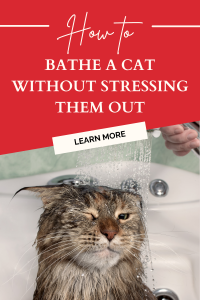
Splash Without Stress: A Gentle Guide to Bathing Your Cat
The mere mention of bathing a cat often conjures images of scratched arms, frantic meows, and a very unhappy feline. While many cats spend their lives avoiding water, there are times when a bath becomes a necessity – whether due to excessive soiling, matting, skin conditions, or even just a particularly messy adventure. The good news is that with the right preparation, a calm approach, and a focus on minimizing stress, bathing your cat doesn’t have to be a traumatic experience for either of you.
When is a Bath Necessary?
Unlike dogs, most cats are fastidious self-groomers and rarely require full baths. However, a bath might be warranted if:
- They’re heavily soiled: If your cat gets into something toxic, sticky, or truly filthy that self-grooming can’t handle.
- They have mobility issues: Older, arthritic, or overweight cats may struggle to groom themselves effectively.
- They have skin conditions: Your vet might recommend medicated baths for fleas, allergies, or other dermatological issues.
- They’re a long-haired breed: Some long-haired cats, especially those with very dense coats, can benefit from occasional bathing to prevent matting and manage shedding.
Preparation is Key: Set the Scene for Success
Before you even think about water, thorough preparation is crucial:
- Gather Your Supplies:
- Cat-specific shampoo: Never use human shampoo, as it can irritate your cat’s skin.
- Several towels: Have at least two large, absorbent towels ready.
- Rubber mat or towel for the tub/sink: This provides traction and prevents slipping, which can be very unsettling for a cat.
- Cotton balls: For gently plugging ears to prevent water from entering.
- A small cup or spray nozzle: For rinsing.
- Treats and toys: For distraction and positive reinforcement.
- Grooming brush/comb: To brush your cat before the bath.
- Pre-Bath Grooming: Always brush your cat thoroughly before a bath. This helps remove loose fur and, more importantly, any mats. Wet mats tighten and become almost impossible to remove without painful pulling.
- Trim Nails: Consider trimming your cat’s nails beforehand. This not only makes them more comfortable but also protects you from accidental scratches.
- Create a Calm Environment: Close bathroom doors and windows to prevent escapes. Ensure the water temperature is lukewarm – test it on your inner wrist. A quiet environment with no sudden loud noises is ideal.
The Gentle Bathing Process: Slow and Steady Wins the Race
- Introduce Water Gradually: Don’t just plunk your cat into a full tub of water. Instead, use a shallow amount (a few inches) at the bottom of a sink or tub with a rubber mat. Gently lower your cat in. If using a spray nozzle, keep the pressure low and steady.
- Start from the Neck Down: Wet your cat’s body, avoiding their face and ears. Use the cotton balls in their ears if they tolerate it. You can use a damp washcloth to gently wipe their face later.
- Apply Shampoo Gently: Apply a small amount of cat-specific shampoo, starting from the neck and working your way down to the tail. Lather gently, massaging the coat. Speak in a calm, soothing voice throughout the process.
- Thorough Rinsing is Critical: This is one of the most important steps. Residue from shampoo can irritate your cat’s skin and coat, leading to licking and discomfort. Rinse thoroughly with lukewarm water until the water runs clear and there are no suds left. Again, avoid the face and ears.
- The Towel Wrap: Once rinsed, immediately wrap your cat snugly in a warm, dry towel. Gently blot and rub to absorb as much water as possible. You may need a second towel.
- Warmth and Comfort: Move your cat to a warm, draft-free room to finish drying. You can gently blow-dry on a very low, cool setting if your cat tolerates it, but most prefer towel drying followed by self-grooming. Never use high heat, as it can burn their skin.
- Positive Reinforcement: The moment the bath is over, reward your cat with their favorite treats, praise, and gentle petting. This helps create a positive association with the experience.
Troubleshooting and Patience
- Don’t Force It: If your cat becomes overly stressed or aggressive, stop the bath and try again another day. Forcing them will only make future baths harder.
- Start Young: If you have a kitten, gently introduce them to water early to accustom them to the sensation.
- Consider a Professional: If your cat is truly impossible to bathe at home, a professional groomer or your veterinarian might be able to help.
While bathing a cat may never be their favorite activity, by approaching it with patience, calmness, and proper technique, you can minimize their stress and ensure their health and hygiene needs are met without turning it into a full-blown battle.
Beyond the Bathtub: Why Grooming Matters for Every Indoor Cat

The image of a majestic, wild cat meticulously cleaning its fur is ingrained in our minds. Our domestic felines carry this innate drive for cleanliness, often spending a significant portion of their waking hours meticulously licking, biting, and pawing at their coats. This incredible self-grooming ability sometimes leads cat owners to believe that indoor cats, safe from the elements and outdoor grime, require minimal, if any, human intervention in their grooming routine. However, this couldn’t be further from the truth.
While indoor cats may not encounter the same level of dirt and debris as their outdoor counterparts, the very act of living indoors presents unique grooming challenges that necessitate our attention. Neglecting an indoor cat’s grooming needs can lead to a cascade of problems, impacting not only their appearance but more crucially, their health and comfort. Let’s delve into why grooming is not just a luxury, but a vital component of care for every indoor cat.
1. The Silent Threat: Hairballs and Digestive Health
This is perhaps the most well-known reason why indoor cats need regular grooming. Cats shed continuously, and their barbed tongues, while efficient at removing loose hair, also mean they ingest a significant amount of it. For outdoor cats, some of this hair might be naturally shed or caught on outdoor surfaces. For indoor cats, almost all shed hair ends up in their digestive system.
While occasional hairballs are normal, an excessive accumulation of ingested hair can lead to a range of digestive issues. Large hairballs can cause blockages, leading to vomiting, constipation, reduced appetite, and in severe cases, even require surgical removal. Regular brushing, especially for long-haired breeds or those prone to heavy shedding, helps remove loose hair before it’s swallowed, drastically reducing the risk of hairball formation and promoting a healthier digestive system.
2. Matting: A Painful and Potentially Dangerous Problem
Mats are dense clumps of tangled fur that form when loose, dead hair isn’t removed from the coat. While more common in long-haired breeds, even short-haired cats can develop mats, particularly in high-friction areas like behind the ears, under the legs, or around the hindquarters. For indoor cats, factors like static electricity (common in dry indoor environments) and lack of natural elements (like wind or rough surfaces that might help shed hair) can exacerbate matting.
Mats are incredibly painful. They pull on the cat’s skin, restricting movement and causing discomfort. Beyond the pain, mats can lead to:
- Skin Irritation and Infections: Trapped moisture, dirt, and bacteria beneath mats create a perfect breeding ground for skin infections, hot spots, and parasitic infestations.
- Restricted Blood Flow: Severe, tight mats can even impede circulation to certain areas of the skin.
- Difficulty Grooming Themselves: Once mats form, cats find it even harder to groom themselves, creating a vicious cycle.
Regular brushing and combing prevent mats from forming by removing loose hair before it has a chance to tangle. If mats are already present, professional grooming might be necessary to safely remove them without injuring the cat.
3. Skin and Coat Health: Beyond Just Hair
A cat’s coat is a reflection of its overall health. Regular grooming sessions offer an invaluable opportunity to:
- Distribute Natural Oils: Brushing helps to spread the natural oils produced by your cat’s skin throughout their coat, keeping it healthy, shiny, and waterproof. This natural barrier protects their skin from dryness and irritation.
- Monitor for Skin Issues: During grooming, you can inspect your cat’s skin for any lumps, bumps, sores, rashes, dry patches, fleas, ticks, or other parasites. Early detection of these issues can lead to quicker and more effective treatment.
- Reduce Allergens: For human allergy sufferers, regular brushing can help reduce the amount of dander (dead skin flakes) and loose fur in the environment, potentially easing allergy symptoms.
4. Nail Care: Preventing Pain and Damage
Indoor cats don’t have the same opportunities as outdoor cats to naturally wear down their claws by climbing trees or walking on rough surfaces. As a result, their nails can grow excessively long, leading to:
- Ingrown Nails: The most painful consequence, where the nail curls around and grows into the paw pad, causing severe pain, lameness, and infection.
- Snagging and Tearing: Long nails are more prone to getting caught on carpets, blankets, or furniture, potentially leading to painful tears or broken claws.
- Behavioral Issues: Pain from long nails can make cats irritable, reluctant to jump or play, and can even contribute to litter box avoidance if stepping becomes uncomfortable.
Regular nail trimming (typically every 2-4 weeks) is crucial for indoor cats to prevent these issues.
5. Early Detection of Health Problems
Grooming sessions are more than just cosmetic. They serve as a routine “health check.” By regularly handling your cat and examining their fur and skin, you are more likely to notice subtle changes that could indicate an underlying health issue. This includes:
- Changes in Weight: Feeling ribs or a prominent spine could signal weight loss; difficulty feeling them could indicate weight gain.
- Lumps or Bumps: Any new growths should always be checked by a veterinarian.
- Sore Spots: Your cat might flinch or react to touch in a particular area, indicating pain.
- Unusual Odors: Persistent bad odors from the coat, mouth, or ears can signal infections or other problems.
- Dental Issues: While not direct grooming, it’s an excellent time to peek at their teeth for signs of tartar or gum disease.
6. Behavioral Benefits and Bonding
Grooming can be a deeply bonding experience for you and your cat. Regular, gentle grooming sessions, especially if introduced early and positively reinforced with treats and praise, can strengthen your relationship. For some cats, grooming is incredibly soothing.
Furthermore, proper grooming can prevent behavioral issues. Cats that are uncomfortable due to mats or painful nails may become irritable, aggressive, or withdrawn. By addressing these physical discomforts, you contribute to a happier, more well-adjusted cat.
Conclusion: A Commitment to Well-being
In conclusion, the notion that indoor cats are exempt from regular grooming is a misconception. From preventing painful mats and dangerous hairballs to ensuring healthy skin and allowing for early detection of health issues, grooming is an indispensable part of responsible cat ownership. It’s an act of love that contributes significantly to your indoor cat’s comfort, health, and longevity, ensuring they continue to purr contentedly for years to come. So, grab that brush, gentle clippers, and embark on a regular grooming routine – your cherished feline companion will thank you for it.
How to Trim Your Cat’s Nails at Home
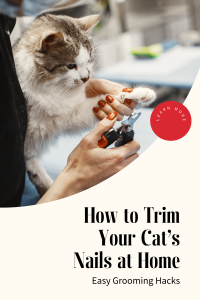
Paw-dicure at Home: A Gentle Guide to Trimming Your Cat’s Nails
Trimming your cat’s nails can seem like a daunting task, filled with visions of scratches and struggles. However, with the right approach, patience, and a little practice, it’s a vital grooming ritual that can be a stress-free experience for both you and your feline friend. Regular nail trims are essential for your cat’s health and well-being, preventing painful ingrown nails, reducing damage to furniture, and making playtime much safer for everyone involved.
Why Trim Your Cat’s Nails?
Unlike dogs, cats’ claws are retractable, but they still grow continuously. Without regular trimming, they can become too long, curving inward and potentially growing into their paw pads, causing pain, infection, and difficulty walking. Long nails can also snag on carpets or furniture, leading to painful tears or injuries. Beyond these health considerations, trimmed nails simply make living with your cat more comfortable for both of you, reducing accidental scratches during play or petting.
What You’ll Need: The Right Tools
Before you begin, gather your supplies:
- Cat-Specific Nail Clippers: There are various types, including scissor-style and guillotine-style. Choose the type you feel most comfortable with. Ensure they are sharp to make a clean cut.
- Styptic Powder (or cornstarch/flour): This is your safety net. In case you accidentally cut too deep and hit the “quick” (the sensitive part of the nail containing blood vessels and nerves), styptic powder will quickly stop the bleeding.
- Treats: Positive reinforcement is key! Have plenty of your cat’s favorite treats on hand.
- A Towel (optional): For wrapping a wriggly cat if needed.
- Good Lighting: Essential for clearly seeing the nail.
The Gentle Approach: Steps for Success
- Choose the Right Time: Select a moment when your cat is relaxed and calm, perhaps after a nap or during a quiet cuddling session. Avoid times when they are overly playful or stressed.
- Get Them Used to Paw Handling: If your cat isn’t accustomed to having their paws touched, start slow. Gently touch their paws, extending a toe and then releasing it, rewarding with treats and praise. Do this frequently until they are comfortable.
- Identify the Quick: Hold your cat’s paw gently and extend a claw by gently pressing on the top of the paw and the paw pad. You’ll see the translucent claw. Inside, there’s a pinkish area – this is the quick. You want to cut only the clear, pointed tip of the nail, avoiding the quick. For dark-nailed cats, the quick is harder to see, so err on the side of caution and only snip the very tip.
- The Snip: With your clippers, make a swift, clean cut just below the quick. If you’re unsure, it’s always better to cut too little than too much. You can always trim more later.
- One Nail at a Time (if necessary): Don’t feel pressured to do all 18 claws at once (remember, cats have five toes on each front paw and four on each back paw, with the dewclaw on the inner front paw). If your cat becomes agitated, stop, give them a treat, and try again later. Focus on getting one or two nails done per session if that’s all they can tolerate.
- Positive Reinforcement: After each successful trim (or even just trying), lavish your cat with praise and immediate treats. This creates a positive association with nail trimming.
- Address Any Accidents: If you accidentally cut the quick and it bleeds, don’t panic. Apply styptic powder or cornstarch/flour with gentle pressure until the bleeding stops. Reassure your cat and stop the session for the day.
Tips for a Smoother Experience:
- Start Young: Introduce nail trimming early in your cat’s life to acclimate them.
- Consistency is Key: Trim nails every 2-4 weeks, depending on your cat’s growth rate. Regular trims make the quick recede, making future trims easier.
- Wrap if Needed: For a very squirmy cat, gently wrap them in a towel (leaving one paw exposed at a time) for added security.
- Enlist Help: A second person can help hold and distract your cat with treats while you trim.
- Stay Calm: Cats pick up on your energy. If you’re stressed, they will be too.
- Know When to Call a Pro: If you’re truly uncomfortable or your cat is overly aggressive, don’t hesitate to ask your veterinarian or a professional groomer for assistance. They can often provide a demonstration or trim the nails for you.
With patience, positive reinforcement, and the right tools, trimming your cat’s nails at home can become a routine part of their care, contributing significantly to their overall health and comfort.
10 Vet-Approved Tips for a Healthier Cat!
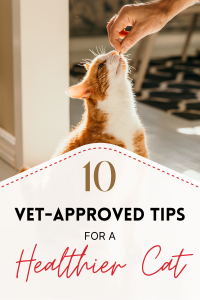
Unlocking a Lifetime of Purrs: 10 Vet-Approved Tips for a Healthier Cat
Cats are enigmatic creatures, celebrated for their independence, grace, and sometimes, their mysterious ways. As devoted cat parents, we want nothing more than for our feline companions to live long, healthy, and happy lives. While their self-sufficient nature might lead some to believe they require minimal care, the truth is that proactive measures and attentive observation are key to ensuring their well-being. To help you navigate the world of feline health, we’ve compiled ten vet-approved tips that can make a significant difference in your cat’s vitality and longevity.
1. The Foundation of Health: A High-Quality, Balanced Diet
Just like humans, a cat’s health begins with what they eat. Cats are obligate carnivores, meaning their bodies are designed to thrive on a diet rich in animal protein. Look for cat foods where meat, poultry, or fish are listed as the primary ingredients. Avoid foods with excessive fillers, by-products, or artificial additives.
Veterinarians often recommend incorporating wet food into your cat’s diet, as it provides crucial hydration that dry kibble alone often lacks. Many cats, especially those on an exclusively dry food diet, can be chronically dehydrated, which can contribute to urinary tract issues and kidney problems. Discuss your cat’s age, activity level, and any specific health concerns with your veterinarian to determine the best nutritional plan and appropriate portion sizes. Free-feeding (leaving food out all day) can lead to obesity, a common and serious health issue in cats.
2. Hydration is Key: Encouraging Ample Water Intake
Building on the previous point, proper hydration is paramount. Cats, as descendants of desert dwellers, don’t have a strong thirst drive. This makes it challenging to ensure they drink enough water. Beyond wet food, consider investing in a pet water fountain, as many cats are attracted to the flowing water. Offer multiple water bowls in different locations, ensuring they are clean and refilled daily. Some cats even prefer ceramic or glass bowls over plastic.
3. The Power of Prevention: Regular Veterinary Check-ups
Even if your cat appears perfectly healthy, annual (or biannual for senior cats) veterinary check-ups are non-negotiable. These routine visits allow your vet to perform a thorough physical examination, detect subtle changes that might indicate early-stage health issues, and keep vaccinations up-to-date. Early detection of conditions like dental disease, kidney disease, hyperthyroidism, or diabetes can lead to more effective treatment and a better prognosis. Your vet can also provide personalized advice on parasite prevention (fleas, ticks, worms) based on your cat’s lifestyle.
4. Dental Health Matters: Beyond Fresh Breath
Dental disease is one of the most common health problems in cats, affecting a vast majority of felines over the age of three. Plaque and tartar buildup can lead to gingivitis, painful extractions, and even systemic health issues if bacteria from the mouth enter the bloodstream.
While regular professional dental cleanings under anesthesia are often necessary, you can support your cat’s oral health at home. Introduce tooth brushing with a cat-specific toothbrush and toothpaste (never human toothpaste!) gradually and patiently. Dental treats and certain dental diets can also help, but always consult your vet for the most effective strategies for your cat.
5. Get Them Moving: Regular Exercise and Play
Obesity is a growing epidemic among domestic cats, leading to a myriad of health problems including diabetes, arthritis, and heart disease. Regular exercise is crucial for maintaining a healthy weight and providing mental stimulation.
Engage your cat in interactive play sessions daily using wand toys, laser pointers (but always end with a tangible reward like a treat to prevent frustration), or puzzle feeders that encourage them to “hunt” for their food. Cat trees, climbing shelves, and scratching posts satisfy their natural instincts to climb, scratch, and observe their surroundings from elevated perches, contributing to both physical and mental well-being.
6. The Litter Box Lowdown: Cleanliness and Accessibility
A clean and appropriately placed litter box is vital for both your cat’s physical and psychological health. Cats are fastidious creatures and can develop litter box aversion if their environment isn’t up to their standards.
Scoop the litter box at least once daily, and thoroughly clean and replenish the litter entirely every 1-2 weeks, depending on the type of litter. The general rule of thumb for multi-cat households is one litter box per cat, plus one extra. Ensure the litter box is in a quiet, accessible location, away from their food and water bowls. Changes in litter box habits (e.g., urinating outside the box, straining, frequent visits) warrant immediate veterinary attention, as they can be signs of serious medical conditions.
7. Grooming for Good Health: More Than Just a Pretty Coat
While cats are renowned self-groomers, they still benefit from human assistance, especially long-haired breeds or those with mobility issues. Regular brushing helps to remove loose fur, preventing uncomfortable mats and reducing hairballs. It also stimulates blood circulation to the skin and distributes natural oils, leading to a healthier, shinier coat.
Use grooming sessions as an opportunity to check for any lumps, bumps, parasites, or skin irritations. Regular nail trims are also important to prevent ingrown nails and discomfort. If your cat resists grooming, introduce it gradually with positive reinforcement.
8. Mental Stimulation and Environmental Enrichment:
Boredom can lead to stress and behavioral problems in indoor cats. Provide a stimulating environment with a variety of toys, scratching surfaces (both horizontal and vertical), and opportunities for vertical exploration (cat trees, shelves). Rotate toys regularly to keep things interesting. Consider window perches where your cat can watch birds and the outside world. Puzzle toys that dispense treats can also provide engaging mental challenges.
9. Spay or Neuter: A Crucial Step for Health and Behavior
Spaying or neutering your cat offers numerous health and behavioral benefits. For females, it eliminates the risk of uterine infections and tumors, and significantly reduces the risk of mammary cancer. For males, it reduces the risk of testicular cancer and certain prostate problems. Beyond health, it often curtails undesirable behaviors such as spraying, roaming, aggression, and the incessant vocalization associated with heat cycles. It also plays a vital role in controlling pet overpopulation.
10. Be an Observer: Recognizing Subtle Changes
Cats are masters at hiding illness, a survival instinct from their wild ancestors. As a result, subtle changes in their behavior or routine can be the earliest indicators of a health problem. Pay close attention to changes in appetite, thirst, litter box habits (frequency, volume, consistency), activity levels, sleep patterns, grooming habits, and vocalizations. Any sudden or persistent changes warrant a call to your veterinarian. Early intervention can make a world of difference in the outcome of many conditions.
By implementing these ten vet-approved tips, you’re not just providing basic care; you’re actively investing in your cat’s long-term health and happiness. A healthy cat is a happy cat, and the bond you share will only grow stronger with every purr.
7 Signs Your Cat Needs A Grooming Session
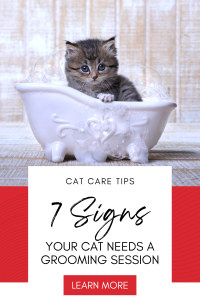
Decoding the Signals: 7 Undeniable Signs Your Feline Friend Needs a Grooming Session
Our feline companions are masters of subtle communication. From the gentle blink of an eye to the rhythmic purr, they have their own unique language. Among the many messages they convey, understanding when your cat needs a grooming session is crucial for their health, comfort, and overall well-being. While some cats are fastidious self-groomers, even the most diligent felines can benefit from a little extra help. Recognizing the signs early can prevent discomfort, matting, skin issues, and even potential health complications. Here are seven undeniable indicators that your beloved cat is due for some pampering:
1. The Tangled Tale: Noticeable Mats and Knots in Their Fur
One of the most obvious and concerning signs that your cat needs grooming is the presence of mats or knots in their fur. These tangled clumps are more than just unsightly; they can be incredibly painful for your cat. Mats typically form in areas where friction is common, such as behind the ears, under the legs, along the back, and near the tail.
The formation of mats begins with loose fur that doesn’t get brushed away. As the cat moves and grooms, this loose fur intertwines with healthy hair, creating small tangles. Over time, these tangles tighten and grow larger, forming dense mats that pull on the skin. This pulling can cause significant discomfort, restricting movement and even leading to skin irritation, bruising, and infections underneath the mat.
Furthermore, mats can trap moisture, dirt, and debris close to the skin, creating a breeding ground for bacteria and parasites. In severe cases, matted fur can even impede blood circulation. If you notice any mats or knots, especially if they are large or close to the skin, it’s a clear indication that your cat needs professional grooming assistance. Trying to remove large, tight mats yourself can accidentally injure your cat, so seeking expert help is always the safest option.
2. An Overabundance of Shedding: More Than the Usual Fluff
While shedding is a natural process for cats, an excessive increase in the amount of fur they are losing can be a sign that they need grooming. Regular brushing helps to remove loose and dead hair, preventing it from being shed all over your home. When this loose fur isn’t removed, it can contribute to matting and also means your cat is likely ingesting more hair during their own grooming sessions, potentially leading to more frequent and larger hairballs.
If you find yourself constantly sweeping up piles of fur, or if your cat’s coat appears thinner or less lustrous than usual, it could indicate that they need help removing the excess dead hair. A thorough brushing session can significantly reduce shedding and improve the overall health and appearance of their coat. For long-haired breeds, regular and consistent brushing is even more critical to manage shedding effectively.
3. A Dull and Lifeless Coat: Losing Their Natural Shine
A healthy cat’s coat should have a natural sheen and vibrancy. When a cat’s grooming needs are not being met, their fur can start to look dull, dry, and even greasy in some areas. This lack of luster can be due to a buildup of dead hair, dirt, and oils on the surface of the coat.
Regular brushing helps to distribute the natural oils produced by your cat’s skin throughout their coat, keeping it healthy and shiny. When these oils aren’t properly distributed, the coat can lose its natural protective barrier, making it more prone to dryness and tangling. A dull coat is a visual cue that your cat isn’t able to effectively groom themselves or that they have an excess of dead hair that needs to be removed through brushing.
4. Excessive Scratching and Licking: Signs of Skin Irritation
While some scratching and licking are normal cat behaviors, a noticeable increase in these activities can indicate skin irritation or discomfort, often linked to inadequate grooming. Mats and tangled fur can pull on the skin, causing itching and irritation. Trapped dirt, debris, and even parasites within the coat can also lead to excessive scratching and licking in an attempt to find relief.
If you observe your cat constantly scratching, particularly in specific areas, or if they are excessively licking, leading to bald patches or inflamed skin, it’s important to consider whether their grooming needs are being met. Addressing any matting or buildup of debris through grooming can often alleviate these skin issues. However, if the scratching and licking persist even after grooming, it’s crucial to consult with a veterinarian to rule out any underlying medical conditions or allergies.
5. Visible Dirt and Debris: A Coat That Needs a Clean Sweep
Cats are generally meticulous about their cleanliness, but sometimes they need our help to keep their coats free of dirt and debris. If you start noticing visible dirt, dust, or even small pieces of litter clinging to your cat’s fur, it’s a sign that they may not be able to groom themselves effectively.
This can be particularly true for older cats, overweight cats, or cats with mobility issues who may find it difficult to reach certain areas of their body. Long-haired cats are also more prone to accumulating outdoor debris in their fur. Regular brushing not only removes loose fur but also helps to dislodge any trapped dirt and keep their coat clean and healthy. In some cases, a bath might also be necessary to thoroughly cleanse their coat, especially if they’ve gotten into something particularly messy.
6. Strong Odor: More Than Just a Feline Scent
While cats have their own natural scent, a strong or unpleasant odor emanating from their coat can be a sign of a grooming issue. Trapped dirt, oils, and even mild skin infections under matted fur can contribute to an unpleasant smell. Additionally, if your cat is having difficulty grooming certain areas, such as around their rear end, it can lead to a buildup of waste and a noticeable odor.
Regular grooming, including brushing and potentially bathing, can help to remove the sources of these odors and keep your cat smelling fresh and clean. If the strong odor persists even after grooming, it’s important to consult with a veterinarian, as it could indicate an underlying health problem.
7. Changes in Behavior: Irritability or Reluctance to Be Touched
Sometimes, the signs that your cat needs grooming are more behavioral than physical. If your usually affectionate cat becomes irritable or reluctant to be touched in certain areas, it could be a sign that they have mats or skin irritation causing them discomfort. They may hiss, swat, or try to avoid being handled, especially in areas where their fur is tangled or their skin is inflamed.
Paying attention to these changes in your cat’s demeanor can provide valuable clues about their grooming needs. If you notice them becoming more sensitive or reactive to touch, gently examine their coat for any signs of matting or skin issues. Addressing these problems through careful grooming can often restore their comfort and their usual loving disposition.
Conclusion: Prioritizing Your Cat’s Grooming Needs
Recognizing these seven signs is key to ensuring your cat remains healthy, comfortable, and happy. Regular grooming is not just about aesthetics; it plays a vital role in preventing matting, reducing shedding, maintaining skin health, and even strengthening the bond between you and your feline companion. The frequency and type of grooming your cat needs will vary depending on their breed, coat length, age, and overall health. However, being vigilant for these telltale signs will help you determine when it’s time to reach for the brush, schedule a professional grooming appointment, or simply dedicate some quality time to pampering your purrfect friend. By understanding their subtle communication, you can proactively address their grooming needs and contribute to their long and fulfilling life.
The Ultimate Guide to Cat Training for Men: Tips and Tricks for a Well-Behaved Kitty
20 Apartment-Living Problems with Cats
For many years my cat and I lived in an apartment and the list of 20 Apartment-Living Problems with Cats that I noticed when doing so is listed below.
Limited Space and Exercise:
- Lack of vertical space: Apartments lack the climbing opportunities cats crave, leading to boredom and restlessness.
- Not enough playtime: Confined spaces make tiring cats out difficult, resulting in destructive behaviors like furniture scratching.
- No access to the outdoors: Outdoor enrichment like chasing bugs or sunbathing becomes unavailable, which can be frustrating for cats.
Litter box and Hygiene:
- Litter box odor: Confined apartments can amplify litter box smells, especially for single-litter-box households. With the right kitty litter and daily cleaning of it became a lesser problem.
- Litter box placement limitations: Finding a discreet and convenient location for a litter box in a small space can be challenging.
- Difficulty maintaining litter box cleanliness: Frequent litter changes and cleaning might be necessary due to closer proximity to living areas.
Noise and Neighbor Issues:
- Meowing: Apartment walls can amplify cat vocalizations, leading to complaints from neighbors or feelings of self-consciousness.
- Running and jumping: Active cats in small spaces can create noise from running, jumping, and playing, disturbing neighbors. The Zoomies.
- Scratching on doors and walls: Lack of appropriate scratching posts might lead cats to scratch on furniture or doors, causing damage and noise.
Safety and Security:
- Open windows and balconies: Accidental falls from windows or balconies pose a serious danger to apartment-dwelling cats.
- Escape risk: Open doors or unlocked windows can lead to escapes, with the city environment posing dangers to lost cats. I did live in New York City bough of Queens near a major blvd.
- Poisonous plants: Many common houseplants are toxic to cats, requiring careful plant selection and placement. I got a list and my the previous post mentioned the plants.
Socialization and Enrichment:
- Loneliness: Cats left alone for long periods in apartments can become lonely and stressed. Nor all my apartments my one in NYC had other cats, but male cats always don’t get along.
- Lack of cat-friendly interactions: Limited exposure to other animals or people can make socialization difficult.
- Mental stimulation issues: Apartment life can restrict opportunities for hunting, foraging, and exploring, leading to boredom.

Orange Maine Coon by Thirdman from Pexel
Additional issues:
- Heat regulation: Cats can struggle to regulate their temperature in small, poorly-ventilated apartments.
- Traveling with cats: Moving apartments or going on trips can be stressful for cats due to changes in environment. Note this is also if you live in a house.
- Pet fees and restrictions: Some apartment buildings have pet fees or restrictions, adding financial and logistical hurdles.
- Finding cat-friendly apartments: Finding an apartment with suitable amenities and policies for cats can be challenging. It does take longer on both Craigslist and other online classifieds and apartment websites, I had to skip more then half of them because they would say no pets.
- Balancing cat needs with apartment living: Accommodating a cat’s natural instincts and needs within the limitations of apartment life can be a constant negotiation.
Remember, these are just some common problems, and the specific challenges will vary depending on individual cats and apartment situations.


